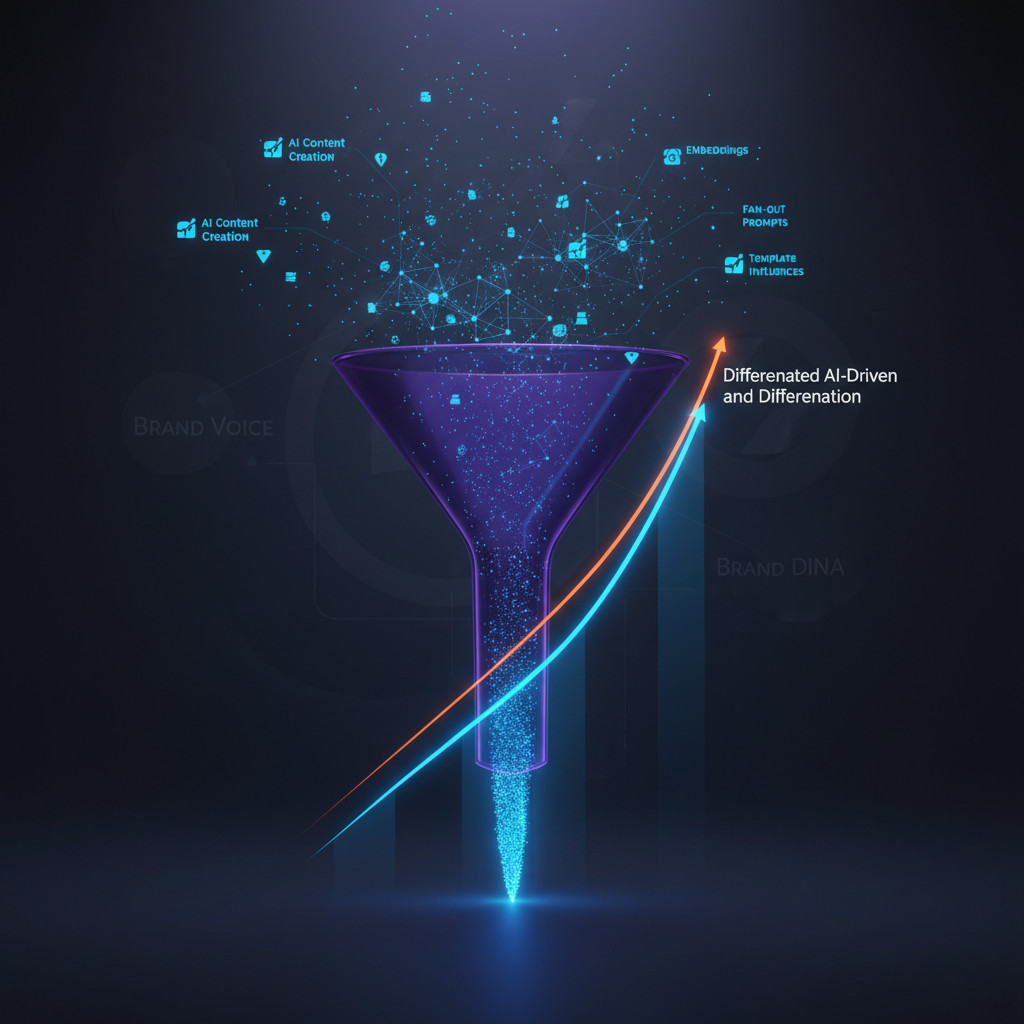AI-driven SEO and Content Differentiation
AI-driven SEO and content differentiation is no longer optional for brands that want to stand out.
Across industries, generative models write similar answers because they trained on overlapping data.
As a result, search engines treat many pages as duplicates of meaning.
However, editors can fight this sameness by using tools and tactics that inject brand DNA.
For example, a Brand Bible, Template URL, and fan-out prompts guide unique voice and topic coverage.
Therefore, combining human-in-the-loop edits with predictive metrics gives editors x-ray vision.
In this article, we will show actionable fixes and workflows to reclaim distinct rankings.
You will learn to use embeddings, semantic clustering, and link strategy to beat AI sameness.
Also, we explain how Market Brew style Content Booster and Light Brew ideas help predict performance.
Read on to get concrete steps editors can adopt today.
Start here with the Brand Bible and fan-out prompts.
Then test and refine.

What is AI-driven SEO and content differentiation?
AI-driven SEO and content differentiation means using machine learning to make content distinct and discoverable. In practice, teams combine embeddings, semantic clustering, and brand rules. This approach prevents AI sameness and gives editors control. For example, a Brand Bible injects Brand DNA. Fan-out prompts expand topic coverage. As a result, pages avoid duplicate meaning and compete more effectively.
How AI-driven SEO and content differentiation transforms traditional SEO
AI changes classic SEO in three big ways. First, it shifts optimization from keyword stuffing to semantic relevance. Second, it replaces guesswork with predictive metrics like embedding clusters and fan-out coverage. Third, it embeds content creation within a search engine simulation so teams can test outcomes before publishing.
Moreover, tools such as Market Brew demonstrate predictive SEO in action. See Market Brew for examples at Market Brew. For basic SEO principles and why relevance matters, read Moz. For industry trends and case studies, consult Search Engine Journal.
Practical benefits of using AI for SEO and content strategy
- Improved ranking: AI finds semantic signals search engines reward. Therefore, content ranks higher for intent, not just keywords.
- Personalized content: AI lets teams tailor pages by persona and context, increasing engagement and conversions.
- Faster research: Consequently, editors map topic gaps and fan-out prompts more quickly.
- Competitive advantage: Brands that teach AI their voice win unique SERP space.
- Predictive visibility: Teams measure link distribution and semantic similarity before launch.
In short, AI-driven SEO and content differentiation turns generic outputs into brand-unique assets. Editors keep final control while AI scales research and testing. As a result, teams get both efficiency and distinct rankings.
Comparison: Traditional SEO vs AI-driven SEO and content differentiation
Below is a quick comparison to show how classic methods differ from modern, AI led approaches. Therefore, this table helps editors choose the right workflow.
| Aspect | Traditional SEO | AI-driven SEO and content differentiation |
|---|---|---|
| Methodology | Rule based tactics and manual keyword lists | Semantic embeddings, fan-out prompts, and Brand Bible influence |
| Efficiency | Time intensive research and manual audits | Automated pipelines and predictive testing speed work up |
| Personalization | Generic pages for broad segments | Persona aware pages and dynamic content variants |
| Adaptability | Slow to update after algorithm shifts | Rapid iteration with human-in-the-loop controls |
| Results | Gains from on page tweaks and links | Improved intent match, fewer duplicate meanings, and clearer brand voice |
| Workflow control | Editor heavy with limited tooling | X-ray visibility, template influence, and agent-driven stages |
Use this table as a guide when moving from classic SEO to AI first systems.
Evidence and case studies: measurable wins
Real world data shows AI-driven SEO delivers tangible gains. For example, industry surveys report a median organic traffic lift when teams adopt AI tools. According to one summary, sites using AI SEO saw an average organic traffic increase of 52% source. Meanwhile, conversion metrics improved in parallel across studies.
Other sources highlight efficiency and content relevance gains. One analysis found a 28% boost in conversion rates after AI optimization source. Another report shows content teams reported a 67% increase in production efficiency and a 43% reduction in content costs source; source. These figures do not replace careful tracking. However, they show clear upside when teams use AI for research and differentiation.
Concrete signals editors have seen include
- +52% organic traffic growth on average when AI tools guide topic selection and optimization source
- +28% lift in conversion rates after personalized, AI informed content changes source
- 67% faster content production and 43% lower content costs in AI enabled teams source; source
How to interpret and measure results
- Track organic sessions and source segments weekly
- Measure conversion rate by landing page and persona
- Monitor semantic similarity and embedding cluster overlap to avoid duplicate meaning
- Watch link distribution and internal linking patterns before launch
Publishers and agencies adopt mixed workflows. For example, combining a Brand Bible with fan-out prompts builds unique topic maps. Teams then run content through search engine simulations. Although exact lifts vary by niche, many report faster ranking for targeted queries and stronger user engagement. Predictive metrics to watch include:
- Fan-out coverage: breadth of topic territory covered
- Audience compliance: alignment with persona intent
- Semantic similarity score: distance from competitor embeddings
- Link distribution: internal and external link spread
- Engagement: pages per session and average time on page
Finally, predictive platforms give a dry run. Market Brew provides search engine simulations and visibility controls to test content before publishing source. Therefore, editors can proof outcomes and reduce risk.
AI-Driven SEO and Content Differentiation
AI-driven SEO and content differentiation gives editors practical ways to beat AI sameness and win distinct rankings. By combining semantic embeddings, fan-out prompts, and a Brand Bible, teams create voice and authority. Consequently, you get content that aligns with intent and stands out in search. Moreover, predictive metrics let editors test outcomes before publishing.
Editors should adopt human-in-the-loop workflows and search engine simulations. For example, map topic gaps, set Template Influence, and measure embedding clusters. As a result, teams reduce duplicate meaning and improve conversion rates. Finally, fast iteration cuts time to publish and lowers content costs.
Velocity Plugins
Velocity Plugins specializes in AI-driven WooCommerce plugins that solve real ecommerce problems. Their flagship product Velocity Chat boosts conversions and cuts support costs by handling common customer questions. Therefore, ecommerce teams see better conversion rates and fewer support tickets when they deploy the tool. Be confident and start small. Test a Brand Bible, run a Content Booster style simulation, and measure fan-out coverage. In short, the future rewards teams that teach AI to think like their brand and editors who keep control.
Frequently Asked Questions (FAQs)
What is AI-driven SEO and content differentiation?
AI-driven SEO and content differentiation uses machine learning to make content unique and discoverable. It combines embeddings, Brand Bible rules, and fan-out prompts to shape voice and coverage. Therefore, editors keep control while AI scales research.
How does it differ from traditional SEO?
Traditional SEO focuses on keywords, links, and manual audits. By contrast, AI-driven approaches prioritize semantic relevance and predictive testing. This change reduces duplicate meaning and improves intent matching.
What metrics should teams track?
Track a mix of performance and semantic signals.
- Organic sessions and landing page conversion rates
- Semantic similarity and embedding cluster overlap
- Fan-out coverage and audience compliance scores
- Link distribution and engagement metrics like time on page
Can small teams adopt these methods?
Yes, small teams can adopt AI-driven SEO. Start with a Brand Bible and a single template test. Also, use human-in-the-loop checks to keep voice consistent.
How quickly will I see results?
Results vary by niche and effort. However, teams often see faster ranking for targeted queries. Consequently, expect iterative gains over weeks, not overnight miracles.



